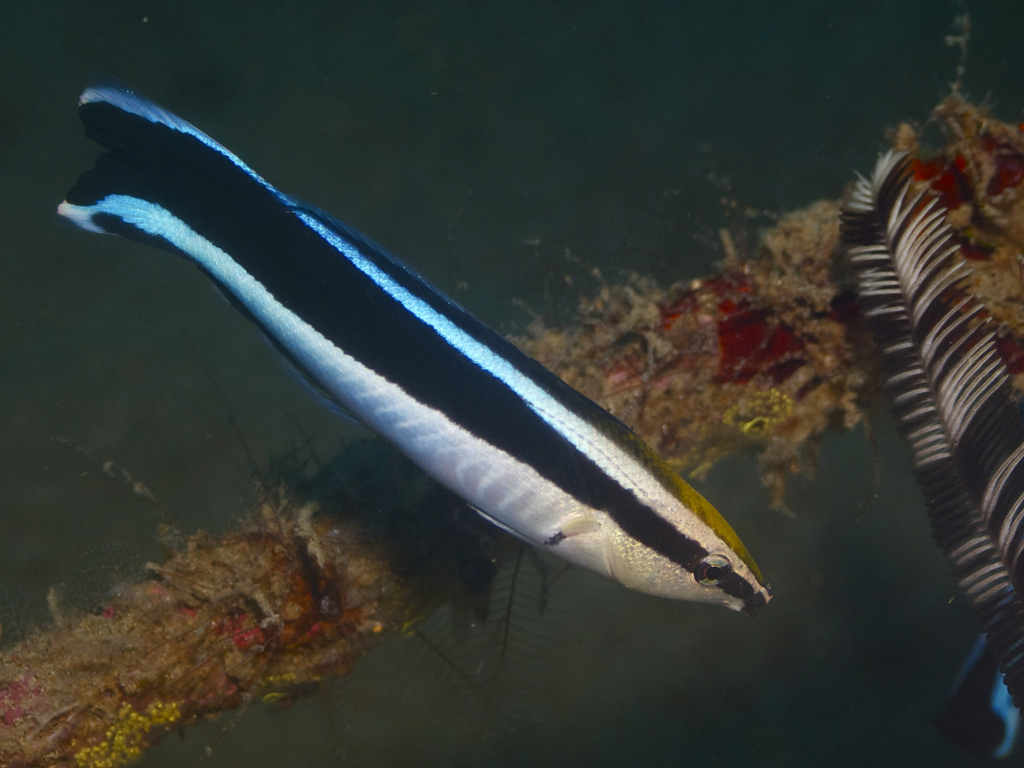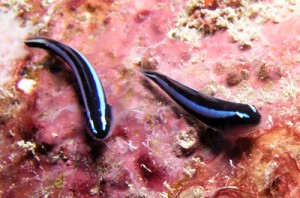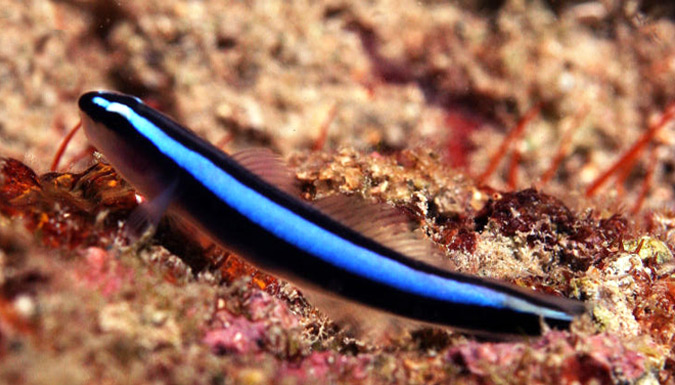Imagine you have your heart set on getting a cleaner fish for your marine aquarium so you can observe this iconic form of symbiosis right in your own home. Now imagine you’re in your local fish store looking at two tanks positioned side by side.
In the left tank, wearing light blue and black horizontal stripes, is the neon cleaner goby (Elacatinus oceanops). In the right tank, sporting nearly identical blue and black stripes, is the bluestreak cleaner wrasse (Labroides dimidiatus). Which cleaner should you choose?
To help you make an informed (albeit imaginary) decision, let’s put these two contenders together in the ring for a few rounds to see who comes out on top when it comes to aquarium suitability.
Round 1: Captive cleaning behavior
 Both E. oceanops and L. dimidiatus are fairly reliable when it comes to cleaning their piscine tankmates, which is not only fascinating to observe, but can also reduce the numbers of external parasites, such as marine ich (Cryptocaryon irritans), on their cleaning clients. So, neither species is a clear winner in round 1.
Both E. oceanops and L. dimidiatus are fairly reliable when it comes to cleaning their piscine tankmates, which is not only fascinating to observe, but can also reduce the numbers of external parasites, such as marine ich (Cryptocaryon irritans), on their cleaning clients. So, neither species is a clear winner in round 1.
Round 2: Dietary adaptability
E. oceanops is a facultative cleaner. In other words, this species doesn’t depend on the byproducts of its cleaning behavior for sustenance. In fact, most specimens adapt with little difficulty to a captive diet of small, meaty, non-living foods.
L. dimidiatus, on the other hand, is an obligate cleaner, which means it sustains itself on the parasites, mucus, and dead tissue it picks from client fish and seldom accepts substitute foods. Thus, most specimens slowly starve to death in captivity unless kept in a very large system with numerous fish tankmates. Even then, the resident fish population is unlikely to provide enough sustenance to support the long-term survival of this species. Some specimens do thrive in suitable aquariums, but the vast majority of them do not.
Round 2? A decisive win for E. oceanops!
Round 3: Sustainability
 Captive-bred specimens of E. oceanops are readily available on the aquarium market, so it’s easy and affordable to own one without having any impact whatsoever on wild reefs.
Captive-bred specimens of E. oceanops are readily available on the aquarium market, so it’s easy and affordable to own one without having any impact whatsoever on wild reefs.
The same cannot be said for L. dimidiatus, however. To my knowledge (fellow salties, if I’m wrong on this, let me know in the comment section below), this species has not been captive-bred—at least not on a commercial scale—so all specimens in the trade are wild-collected.
The wild capture of cleaner wrasses—again, most of which are doomed to starve in captivity—not only puts pressure on wild stocks of this species, but also adversely impacts many other fish species on the reefs due to the loss of a predictable “cleaning service.”
Hands down, round 3 goes to E. oceanops.
And the winner is…
After three hard-fought rounds between two worthy contenders, the winner in The Great Cleaner Wrasse and Cleaner Goby Throwdown is most decidedly E. oceanops.




Hey great article! I did my thesis on the biological eradication of ich in marine aquaria. I did a control study and tested cleaner wrasse, cleaner goby, cleaner shrimp and one you left out and my clear winner, sharknose goby or Elactinus evelynae. I need to send Chris my findings. One of my favorite fish
Very interesting, Jon. I’d love to read through your findings. I’ve like to keep E. oceanops in my tanks (the ones where they’ll survive). Another degree of my Carib obssession…Jeff doesn’t call me “Caribbean Chris” for nothing, haha!
Anyway, I need some E. evelynae in my life. They’ve always interested me but I’ve never come across or sought one out. I recently lost the last of my neon goby pair (darn their relatively short life span), so I might have to look around for a sharknose as a replacement.
Nice write up Jeff, I always enjoy when information is put out there that helps people make a conscientious choice! I have always heard what the article says, that the cleaner wrasse is best left in the ocean. I’m glad Dan had a stroke of good luck, but hope that LFS will increasingly stock the goby over the wrasse.
Thanks Matt! If we all keep voting with our pocketbooks, hopefully market forces will help bring that about.
Hey guys, I picked up a cleaner wrasse from an LFS about 6 months ago, and this gut simply loves Rod’s food. I drop a chunk into the tank and he and my fox face fight over it like its a tug – o – war. He always ends up with a huge belly bulge when he is finished. I don’t know if other cleaner wrasses adapt as well, but mins certainly has.
That’s definitely an encouraging sign, Dan. Keep experimenting with a variety of nutritious foods as long as your adventuresome guy seems willing to try ’em!